Manuel Muñoz, whose debut novel, What You See in the Dark, was just published, joins our continuing series of guest blog posts by writers of fiction, history, essays, and poetry.

Among the early reviewers for Muñoz’s new novel is NPR senior editor Luis Clemens, who writes: “This book knotted my stomach. What You See in the Dark made me tense, and I mean tense. . . . The noir atmospherics are as thick as winter fog and parts of the novel read like a shy love letter to Alfred Hitchcock.”
Below, Muñoz recounts how he first encountered Gwendolyn Brooks’s novel Maud Martha in a class at Harvard.
Gwendolyn Brooks’s first (and only) novel, Maud Martha, came to me as a stack of photocopied pages from a local shop in Harvard Square. The book was out of print and available only in limited quantities, so the class trekked over to the shop to purchase the packet.
This was the early 1990s and the seminar on African-American women writers was led by Henry Louis Gates, Jr. The class was filled mostly with young white women who spoke about Octavia Butler, Ann Petry, Nella Larsen, and Toni Morrison with a commanding authority that I could never place. I sat mostly in silence in that class, bristling at times at how easily some drifted into shaky political commentary, Professor Gates always guiding the seminar back to the solid foundation of the texts at hand.
Professor Gates called me into his office a few weeks into the seminar, along with a beautiful, beautiful young man of mixed heritage (who was the object of my silent crush). I could look neither of them in the eye, and when Professor Gates sat us down and asked why we were so reluctant to speak in class, I had no answer. On the way out, he said, “I need you to speak up.”
It was humbling, to say the least, and Professor Gates said nothing explicitly about the incongruity of a student like me, poor and Chicano, not having a word—not one!—to say about why these women had written about exclusion. From then on, I walked into that seminar terrified, having prepared feverishly for each one, only to come up empty, and watching my beautiful, beautiful crush meet Professor Gates’s challenge head on with his own contributions.

My big chance arrived when it came time to discuss Maud Martha. While I had respected and enjoyed many of the other texts, Brooks’s novel was the first I truly, deeply loved. I had been moved by it: a slim novel, it managed an epic arc by the simplest of conceits, the construction of a life via the careful arrangement and presentation of thirty-four episodic chapters. It was an odd novel, to be sure—short, but dazzling, with a reliance on poetic devices that forced me (for once) to slow down in my reading. Maud Martha, a woman growing through pre-WWII Chicago, goes hardly anywhere in the novel and does very little—but her mind! An imaginative person, she is cast by Brooks as a person who recognizes that the narrative of one’s life hardly ever matches what we think of as “plot” in a novel. Maud Martha may be confined, but she can perceive, and it is the power of her imagination that allows her to be at once accepting of her position in the world and generous in observing how others manage (or fail) to cope with the same knowledge.
But I couldn’t say a word about Maud Martha in the seminar. Already, I was learning that to admire a book was to speak first and foremost about its content (not its language, not its structure, and, least of all, not its emotion—a book was not to be loved). All I could do was listen to the discussion of the book’s history. It was in this class that I learned why this 1953 novel had fallen out of print, with Brooks failing to get much support from the more visible African-American writers, all male. It was in this class that I learned of Wallace Stevens’s caustic “coon” remark about Brooks, providing context to the bravery of a writer like her crashing the old-boy network of American letters. And it was in this class, too, that I listened to my classmates discuss the novel as a failed experiment, as the work of a poet who clearly was a master of language, but who didn’t understand the basic structure of a novel.
What I didn’t know then was that a great respect is commanded by artists who break rules. What I didn’t know then was that good artists (but maybe not critics) always ask a simple question about formal decisions: why? If a novel is episodic and breaks the expectation of a typical narrative, good artists know the first reaction should never be This is a failure. It should be Why?
But I failed Gwendolyn Brooks by not defending her, by not attempting an answer to Why? I would hate to think of how a writing workshop would dismantle her glorious thirteenth chapter, “Low Yellow,” in which the point of view seems an abrupt change to first person. It is, in fact, a superbly timed self-assertion, a veiled I finally breaking through, all clued in by the slight “Maud Martha thought.” But I couldn’t explain it then. Nor could I explain why the panoramic chapter “Kitchenette Folks,” with its studied detail of Maud Martha’s neighbors, ends up telling us more about Maud Martha as observer than the people being described.
A novel built on allusion and narrative cross-current is difficult to assess, much more so when the choice of the central character is a figure so often dismissed in American society. A woman like Maud Martha (meaning, poor and African-American) isn’t “compelling,” even if she is more literate about her own life than most Americans could ever be about theirs. What I, poor and Chicano, understood immediately about the book, was the desperate need for narrative in whatever shape could be wrestled from the life around. But that was the language of a writer (not a book critic or, worse, a book reviewer) and so I stayed silent.
It is no wonder to me that Maud Martha was underappreciated in its own time and fell out of print. It hurts to think of how even an accomplished writer like Brooks (a Pulitzer winner in poetry by the time this novel appeared in 1953) could be met with such disregard. Her aim was quite simple: James Baldwin, in the opening essay of Nobody Knows My Name, summed it up for many other writers on the margins when he wrote that his investigation of what it meant to be an American was about how “I wanted to find out in what way the specialness of my experience could be made to connect me with other people instead of dividing me from them.”
Maud Martha, the character, was no writer, but Gwendolyn Brooks had her reach the understandings we expect of most novelists. “She watched the little dreams of smoke as they spiraled about his hand,” Brooks writes, as Maud Martha observes her husband Paul at a nightclub, “and she thought about happenings. She was afraid to suggest to him that, to most people, nothing at all ‘happens.’ That most people merely live from day to day until they die. That, after he had been dead for a year, doubtless fewer than five people would think of him oftener than once a year. That there might even come a year when no one on earth would think of him at all.”
It might be just too tough for some readers to bear, that a person whom society never regards as the center of anything could hold such inscrutable and powerful knowledge, the creator of a puzzle only she can unlock.
Manuel Muñoz previously published two acclaimed collections of short stories, Zigzagger and The Faith Healer of Olive Avenue (a finalist for the 2007 Frank O’Connor International Short Story Prize). His story “Tell Him about Brother John” won a 2009 PEN/O. Henry Prize, and Muñoz served as a juror for the 2011 PEN/O. Henry Prize. He is an assistant professor of creative writing at the University of Arizona in Tucson.




